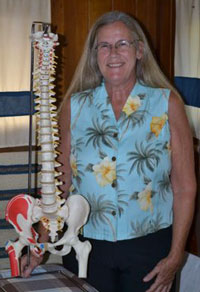
Julie Bacon is a leading North American instructor for the Onsen Techniques™, which is designed for treating pain and enhancing athletic performance. She also teaches classes in Circulatory Massage, a technique designed for increased circulation and deep relaxation, that she developed and taught at Brian Utting School of Massage for 16 years.
She regularly teaches classes in Seattle, WA, and when there is enough interest will arrange to teach in other cities.
Onsen Techniques® Classes
Julie has been practicing massage since 1975 and The Treatment of Pain™ known as Onsen Muscle Therapy™, Onsen Therapy™ or just plain Onsen®, has been her primary treatment tool since 1994. According to Julie, “It is the most effective method for relieving advanced, chronic pain, enhancing athletic performance, and maintaining general health.”
The Onsen Techniques™ was developed by Rich Phaigh, DMT, LMT while working with world class athletes at Nike’s Track West in Eugene, Oregon. It uses visual, palpatory & Range of Motion tests to assess skeletal alignment, and resisted and passive testing to identify the site & source of injury.
The Onsen Techniques® program is divided into four classes (Volumes). Each class is 18 hours long. See a description of each class below.
Circulatory Massage Class
Circulatory Massage is truly a massage with a purpose: systematic, deep, and vigorous, focusing on the return of used blood to the heart. See description below.
Classes Descriptions
You will learn how to palpate bony landmarks in the pelvic region and recognize structural (skeletal) deviations or misalignments.
You will learn passive stretches for each muscle of the lower body, starting with erectors of the lumbar spine.
You learn how far each muscle is supposed to stretch (ROM), in order to determine if a muscle is short and tight or long and overstretched. Resistance and fatigue testing is taught to determine strength disparities between muscle groups; also to reproduce symptoms and identify sources of pain. Finally, students will learn where (specific sites) and how to apply Transverse Friction Massage, and perform scar tissue realigning procedures.
Next you will learn specific Hold/Relax stretches for each misaligned condition. Because each of the stretches targets the specific muscles that are pulling the bones out of alignment, the end result is proper alignment, or correction. Students are taught how to identify and address scapular deviations. They will become familiar with the structural mechanics of the neck, learning specific Hold/Relax stretches to restore mobility to the O/A joint, A/A joint and cervical side-bending (C2 thru C5).
As I observed the embalming procedure, which was to clean all the blood out of the limbs using this same mechanical effleurage that we were being taught, I realized that this wasn’t just a fancy theory — it worked — and on a dead guy even! From that point on, I chose only the strokes working towards that goal to comprise my massage routine. All strokes are toward the heart (massage rule #1!) and designed to impact the veinous half of the circulatory system, which is superficial. (We have access to it, unlike the arterial flow which is buried deep.)
Evacuating the used blood from the muscles paves the way for newly oxygenated (arterial) blood to enter. This cleansing aspect provides an excellent recovery or maintenance massage for those wanting to add to their Sports Massage repertoire. Coincidentally, also because of the increased circulation, this massage is extremely relaxing (think of the post-exercise calm experienced after a good, blood-pumping cardio workout) so it serves well as a standard 1- hour massage in any commercial venue. In fact, this massage has “more bang for the buck” because of its speed: many more strokes are applied in the same time frame as a much slower 1-hour deep tissue massage.
Several Russian massage strokes were added in 1987 after taking a Russian Sports Massage class from Zenya Wine because they are safer for our hands, and are deep and warming without being painful to receive. (Russians believe that pain is bad programming for the body.) Routines will be taught for anterior and posterior legs, arms and back. Please bring top & bottom sheets and wear clothes that can be disrobed easily.
